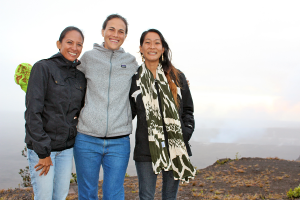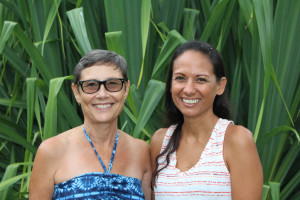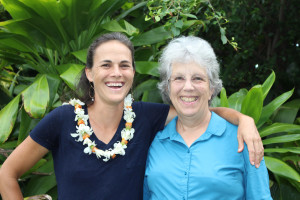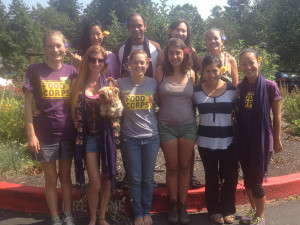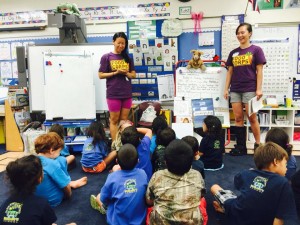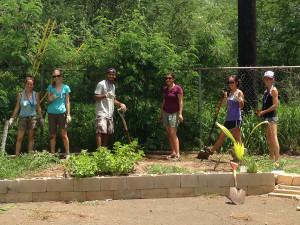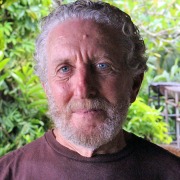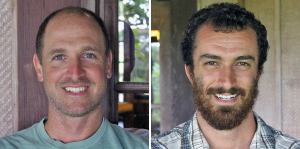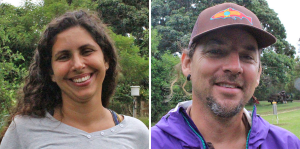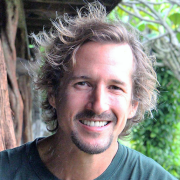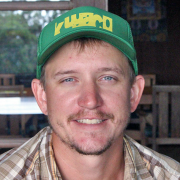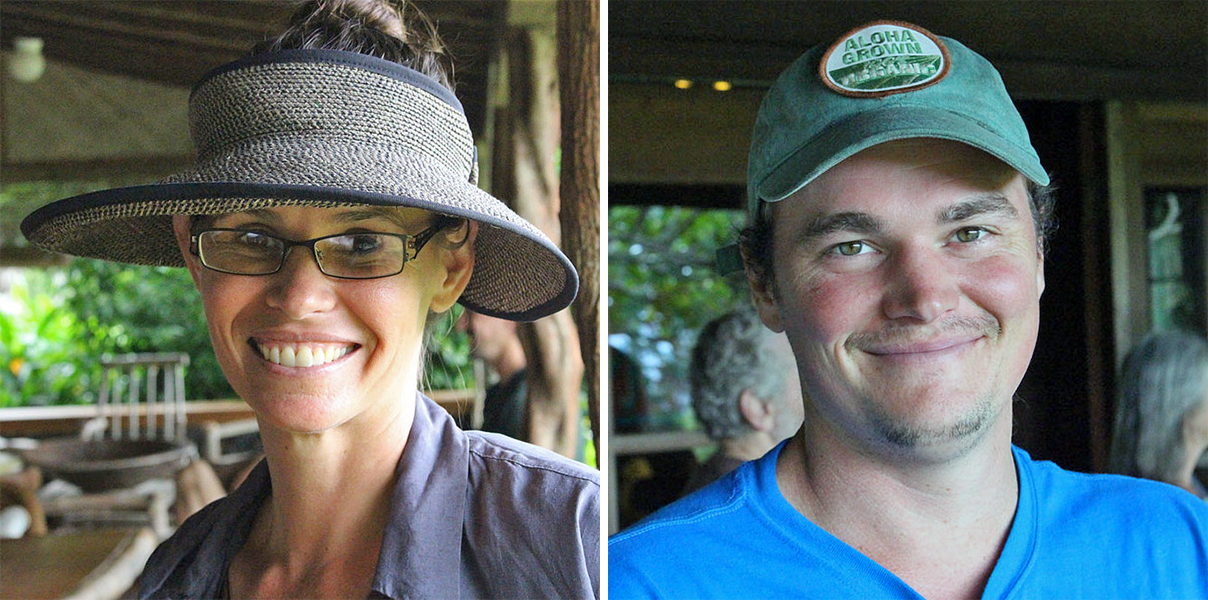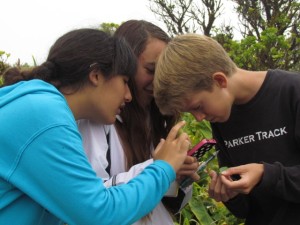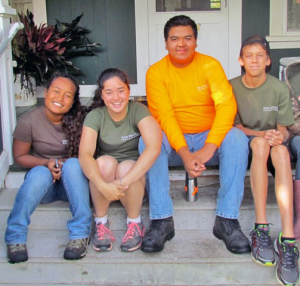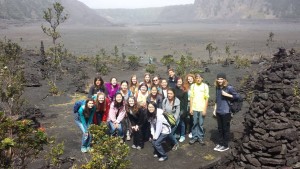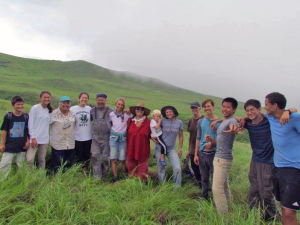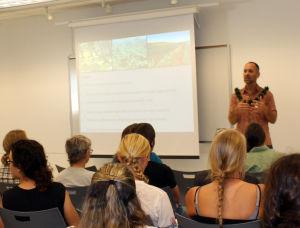IN THIS ISSUE:
Supporting kama‘āina intellectual leadership: The 2015–2016 cohort of Mellon-Hawai‘i Doctoral and Postdoctoral Fellows
FoodCorps Hawai‘i: Connecting island keiki to healthy food, deeper learning, and place
Gathering seeds and cultivating wisdom
Waimea teen inspired to pursue environmental leadership
Program news
Supporting kama‘āina intellectual leadership: The 2015–2016 cohort of Mellon-Hawai‘i Doctoral and Postdoctoral Fellows
Hawai‘i’s future resilience and self-reliance will depend heavily on a new generation of kama‘āina (native-born) leadership to carry our islands forward. Over the past eight years we have administered the Mellon-Hawai‘i Doctoral and Postdoctoral Fellowship Program, awarding more than $1.3 million in fellowships to 32 Kānaka Maoli (indigenous Hawaiian) scholars. Meet this year’s cohort of Hawaiian intellectual leaders, all of whom are conducting and publishing research on critical issues facing island communities.
2015–2016 Mellon-Hawai‘i Fellows (left to right) Kahikina Da Silva, Dr. Mehana Vaughan, and Natalie Kurashima at Halema‘uma‘u, Hawai‘i Island
Established in 2008 with support from the Andrew W. Mellon Foundation and Kamehameha Schools, the Mellon-Hawaiʻi Doctoral and Postdoctoral Fellowship Program recognizes and supports the work of Hawaiian scholars early in their careers as well as others who are committed to the advancement of knowledge about the Hawaiian natural and cultural environment, Hawaiian history, politics, and society. This year’s cohort is also supported by the Deviants from the Norm Fund and Dr. Paul and Elizabeth Nakayama. The program provides mentoring and a one-year stipend to the fellows, enabling doctoral fellows to complete their dissertations before accepting their first academic posts and postdoctoral fellows to publish original research early in their academic careers.
The 2015–2016 cohort is comprised of doctoral fellow Kahikina de Silva, Ph.D. candidate in the political science program at the University of Hawaiʻi at Mānoa; doctoral fellow Natalie Kurashima, Ph.D. candidate in the botany department at the UH Mānoa; and postdoctoral fellow Dr. Mehana Blaich Vaughan, who obtained her Ph.D. from Stanford University in interdisciplinary environmental studies in 2013.
Mellon-Hawai‘i doctoral fellow Kahikina Da Silva (right) with mentor Dr. Noenoe Silva
Kahikina De Silva’s dissertation focuses on mele (songs) and the ways that they represent the long-held Hawaiian values of aloha ʻāina (love of the land). “Kānaka Maoli learn and express our aloha ʻāina in many varied ways, one of which is through composing, singing, and dancing mele,” de Silva explained. “Many of the mele we know and love explicitly address ideas of aloha ʻāina: “Kaulana nā Pua,” “All Hawaiʻi Stand Together,” “I Ola Kākou,” and “E nā Kini” are just a few of these mele lāhui (songs of the Hawaiian people). My dissertation, though, will focus on familiar mele that do not appear at first glance to be particularly nationalistic, but nonetheless have deep underlying currents of aloha ʻāina. This below-the-surface aloha ʻāina influences the poetry of these mele and allows them to transmit their messages of loyalty to land and lāhui in a more subtle, but just as powerful, way.” She contends that “our kūpuna (ancestors) have left for us a vast store of their experiences and manaʻo (thoughts, beliefs), recorded in their own words via mele. It is up to us to strive to understand, cherish, and hoʻoulu (preserve) these mele for generations to come. So doing will strengthen our naʻau (intuition), individually and as a lāhui, in the values and identity of our kūpuna, and guide us as we work for the pono (harmony, well-being) of our ʻāina.” De Silva is being mentored by Dr. Noenoe Silva, professor in political science at UH Mānoa.
Mellon-Hawai‘i doctoral fellow Natalie Kurashima (left) with mentor Dr. Tamara Ticktin
Natalie Kurashima’s research is centered on the restoration of traditional Hawaiian food systems and landscapes as a tool for biodiversity conservation, cultural perpetuation, and resilience against climate change. She was inspired by an undergraduate course that examined issues such as soil loss, damage to marine ecosystems, and food insecurity. She realized that “our kūpuna developed food systems that fed thousands of people for hundreds of years…so I wondered, could we not use our understanding of the past to inform the agricultural systems of today?” Working with mentor Dr. Tamara Ticktin, professor of botany at UH Mānoa, Kurashima hopes to “show that integrating indigenous science and western science knowledge systems increases the overall knowledge base, and is a key tool for the future sustainability of our pae ʻāina.” She would also like to demonstrate that “our indigenous agricultural systems produced comparable levels of food to the food we consume today, and is a viable option for restoration projects across Hawaiʻi.”
Mellon-Hawai‘i postdoctoral fellow Dr. Mehana Vaughan (left) with mentor Dr. Louise Fortmann
Dr. Mehana Vaughan is using her postdoctoral fellowship to complete a manuscript that “focuses on Hawaiian ʻohana (familial) relationships with the coast of the Koʻolau and Haleleʻa districts of North Kauaʻi and how the catching and sharing of fish feed and maintain community. My goal is to tell the story of how Hawaiian families continue to exercise their rights and responsibilities to care for coastal resources, even as Haleleʻa’s popularity as a visitor destination makes it harder for local families to live there.” Her book will examine the challenges of translating ancestral values that have guided relationships with natural resources into state law and contemporary context, keys to overcoming these challenges, and lessons for collaborations between local communities and government to restore sustaining relationships with the ʻāina. Dr. Louise Fortmann, professor of the graduate school and professor emerita at the department of environmental science, policy, and management at the University of California, Berkeley, is Vaughan’s mentor.
Each cohort is selected and convened annually by a distinguished panel of senior scholars and kūpuna (esteemed elders). This panel is comprised of the following members:
- Panel Chair, Robert Lindsey, Jr., Member, Board of Directors, The Kohala Center; and Chairperson, Board of Trustees, Office of Hawaiian Affairs
- Panel Executive Advisor, Dr. Shawn Kanaʻiaupuni, Director, Public Education Support Division, Kamehameha Schools
- Dennis Gonsalves, founding Executive Director, Pacific Basin Agricultural Research Center; and Professor Emeritus, Cornell University
- Pualani Kanahele, Distinguished Professor, Hawaiʻi Community College and member, Board of Directors, the Edith Kanakaʻole Foundation
- James Kauahikaua, Scientist-in-charge, U.S. Geological Survey Hawaiian Volcano Observatory
Applications are now being accepted for the 2016–2017 Mellon-Hawaiʻi Doctoral and Postdoctoral Fellowship Program. More information about the program is available online at MellonHawaii.org or by calling us at 808-887-6411. The deadline to apply is February 29, 2016.
FoodCorps Hawai‘i: Connecting island keiki to healthy food, deeper learning, and place
To combat increasing rates of diet-related maladies such as obesity, diabetes, and hypertension among Hawai‘i’s schoolchildren, we created the Hawai‘i Island School Garden Network to help K–12 schools develop garden programs and educators that connect island youth to healthy food, increased physical activity, and outdoor environments to deepen engagement with core classroom subjects. As the host site for FoodCorps Hawai‘i, we support improved community health by placing food-justice leaders in public and charter schools on three islands to create and strengthen school learning gardens and nutrition programs.
FoodCorps Hawai‘i’s 2015–2016 cohort at the national orientation session in Portland, Oregon in August 2015. Front row (l-r): Mālielani Larish, Kayla Sinotte, Andrea Snow, Carly Wyman, Stephanie Loui, Seri Niimi-Burch. Back row (l-r): Tara Sakamoto, Jameil Saez, Marlena Nip, Tara Celantano.
FoodCorps is a national organization currently operating in 17 states and the District of Columbia that addresses childhood obesity and food insecurity in underserved communities by connecting children to healthy, real food. Through its partnership with AmeriCorps, FoodCorps recruits, trains, and places emerging leaders, known as service members, into limited-resource communities for a year of service. Since 2013, we have served as the host site for the FoodCorps program’s presence in Hawai‘i, under the leadership of Nancy Redfeather, director of our Hawai‘i Island School Garden Network.
Over the past three years, FoodCorps Hawai‘i service members have helped transform school gardens into vibrant spaces of learning and exploration for students and useful, accessible outdoor classrooms for teachers. In 2014–2015 our local FoodCorps team taught more than 2,500 keiki (children) how to grow and cook healthy food, nourish themselves, and mālama ‘āina (care for the land). They harvested 3,500 pounds of produce from their school gardens, using it to teach cooking lessons, sell at farm stands, or give away to students, teachers, and the community. They’ve worked with more than 150 local farmers and 230 volunteers to build connection between farms, schools, and families.
This year FoodCorps Hawai‘i is also supported by the national and Hawai‘i Americorps programs, The Walmart Foundation’s Hawai‘i Giving Council, and from matching funds provided by the schools and service sites at which service members are placed. Led by second-year FoodCorps fellow Andrea Snow, our 2015–2016 service members are:
- Stephanie Loui, Kōkua Hawai‘i Foundation, O‘ahu. Through Kōkua Hawai‘i Foundation Stephanie is serving three public schools on O‘ahu’s North Shore.
- Jameil Saez, Kamaile Academy, O‘ahu
- Marlena Nip and Tara Sakamoto, Sust‘āinable Molokai, Moloka‘i. Through Sust‘āinable Molokai Marlena and Tara are serving all public schools on the island.
- Tara Celantano, Kua O Ka Lā Public Charter School, Puna, Hawai‘i Island
- Carly Wyman, Nā‘ālehu Elementary School, Ka‘ū, Hawai‘i Island
- Mālie Larish, Kona Pacific Public Charter School, South Kona, Hawai‘i Island
- Seri Niimi-Burch, Māla‘ai: The Culinary Garden of Waimea Middle School, South Kohala, Hawai‘i Island
- Kayla Sinotte, Kohala Elementary School, North Kohala, Hawai‘i Island
Tara Sakamoto (left) and Marlena Nip lead a class at Moloka‘i Elementary School.
“FoodCorps is a way for schools to jump-start their garden programs, building necessary infrastructure and integrating it into classes to meet standards while inspiring students to discover a love of science, the natural world, and their community,” said Snow. “You can tell when you walk into a FoodCorps school: there’s a feeling that something special is going on here,” Snow said. “In Hawai‘i, that special something is happening both in the classroom as well as out in the school garden. School gardens bring people together, from aunties in the front office to principals, students, and teachers. Children who struggle with abstract concepts like science and math see them become the forces that cause tangible change in the garden—challenging classroom subjects suddenly come alive in ways kids can connect with.”
Encouraging Hawai‘i’s keiki to deepen their kinship with the ‘āina is a key component of our strategy to revitalize and strengthen local food systems. Hawai‘i service member Seri Niimi-Burch, who was raised on Kaua‘i, wanted to return to the islands after several years in Boston to be a sustainable agriculture educator and support equitable food programs to address health disparities in rural, indigenous, and agricultural communities. Māla‘ai: The Culinary Garden at Waimea Middle School on Hawai‘i Island is an ideal place for her to make a difference. “School gardens and farm to school programs are important on so many levels,” Niimi-Burch said. “School gardens don’t just grow food—they grow people. They give students the opportunity to develop a relationship to the land and the food they eat…something so many children growing up today lack. They are places where keiki can reconnect with their culture, have hands-on experiences that make learning relevant, and develop practical skills that can empower them to grow and cook healthy food in the future.”
FoodCorps Hawai‘i service members gather at Kamaile Academy in Wai‘anae, O‘ahu.
Service member Jameil Saez is serving his second year in FoodCorps Hawai‘i at Kamaile Academy Public Charter School in Wai‘anae, O‘ahu, having served with Sust‘āinable Molokai in 2014–2105. Working in both Kaunakakai and Waiʻanae has been humbling, yet also strengthened within Jameil a sense of purpose. “What I want to accomplish in Wai‘anae this year is simple,” Jameil said. “Improving Kamaile’s learning garden, developing more culturally appropriate lessons, and growing food from the garden to the cafeteria are several of my goals, but if I can do one thing it will be empower at least one student. I serve in a community where homelessness, drugs, and poverty are all too common. If I can help just one of my students find hope and determination in their community, I will feel that I’ve done my service. I believe the garden can be a tool in that empowerment process, so it’s my kuleana (responsibility) to mālama the ‘āina to the best of my abilities. Let’s plant the seeds and wait for the winter rain to come. From that rain life will emerge, a wild forest will sprout, and food will appear feeding our kids’ bodies, souls, hopes, and aspirations.”
Our partnership with FoodCorps and our FoodCorps Hawai‘i service members enable us to extend our work into island schools with student populations that benefit from connecting with real food, improved nutrition, and the ‘āina the most. School gardens not only help children engage with complex academic subjects in more engaging, creative, and real-world ways, they often attract support and involvement from school administrators, families, and surrounding communities. As Snow put it, “I love seeing a whole class, a whole school, a whole community ignite with the excitement of working together to do something good for each other. When I see the community around public schools come together to encourage kids to take care of themselves and the ‘āina, I think the future will be a brighter place.”
Gathering seeds and cultivating wisdom
“It all starts with a seed”—a statement that quite literally applies to our quest to grow and produce more food here in Hawai‘i to reduce our dependence on imports. Simply put, Hawai‘i cannot achieve greater food self-reliance without seeds suited to our local soils and microclimates. Through our Hawai‘i Public Seed Initiative (HPSI), we support passionate seed educators and advocates across the islands dedicated to breeding, testing, saving, and distributing high-performing seeds to farmers and gardeners. Meet some of the local heroes working to increase food production and seed security for Hawai‘i’s future.
Mark House, co-manager of Pu‘u O Hoku Ranch on Moloka‘i, gives retreat participants a tour.
We recently held our third annual retreat for Hawai‘i’s seed leaders at Pu‘u O Hoku Ranch in East Moloka‘i, where 16 seed leaders from Hawai‘i Island, Maui, Moloka‘i, O‘ahu, and Kaua‘i gathered for three days of hands-on seed-saving workshops, seed variety trial presentations, farm tours, and further discussions about the feasibility of an island-wide seed cooperative.
Pu‘u O Hoku managers Mark House and Jann Roney hosted the group at the 14,000-acre ranch which, in addition to being the largest ‘awa farm in Hawai‘i, also maintains a cattle herd and produces honey and a variety of vegetables. Mark and Jann shared the intricacies of the ranch’s seed business, developed by Mark over the past two and a half years and ready to be launched in early 2016. The group toured seed-trial fields, greenhouses, and farm facilities.
After several seed and crop-related working sessions, the group resumed discussions initiated earlier this year about establishing a Hawai‘i-based collaborative seed business. Forest Shomer, a 42-year veteran seed grower who has established two seed companies including Abundant Seeds shared the tools and techniques he has mastered over the years.
Forest Shomer
“If there’s only one source for a lot of these seeds, then we are spreading uniformity around when we share and sell them, which is not really healthy for the environment in the long run,” Shomer told seed leaders. “That is how our economic system tends to centralize everything, when what we need is more diversity. The way we get diversity in this method is through cooperation. This group can work together within our island communities to facilitate multiple collections of the same species and make them as regionally specific as possible.”
With support from the Ceres Trust we’ve distributed mini-grants through HPSI over the years to empower seed leaders across Hawai‘i to advance our work and contribute to greater long-term food security. In 2015 we awarded $18,614 in mini-grants to support ten community-based research and educational efforts on five islands. At the retreat grant recipients provided updates on their respective projects:
Evan Ryan (left) and Elan Goldbart, Maui
Evan Ryan and Elan Goldbart received grant support to continue seed exchanges and workshops on Maui. Their annual Maui Seed and Plant Exchange welcomes seed savers, gardeners, and farmers from across the island and includes a seed workshop. This year’s mini-grant also helped the duo purchase a portable Clipper machine to make the seed cleaning process much more efficient and serve as an important educational tool at seed exchanges and events on Maui. Evan also plans to make the Clipper accessible to other farmers to encourage them to properly clean and save their own seeds to develop high-performing seed varieties.
.
Daniela Dutra-Elliott (left) and Jay Bost, O‘ahu
Mini-grant recipient Daniela Dutra-Elliott, an instructor at Leeward Community College on O‘ahu, tests her students’ scientific literacy by engaging them in seed-variety trials. In collaboration with GoFarm Hawai‘i instructor Jay Bost, Daniela conducts variety trials on broccoli, basil, bean, squash, and corn varieties that have the potential to grow well in Hawai‘i and resist pests and disease. After data are recorded, seeds from varieties that performed well are harvested and cleaned by her students, then made available to the community through the school’s library free of charge. “Seed Parties” are held frequently to bring students, gardeners, and community members together to clean and package seeds.
.
Paul Massey, Kaua‘i
Paul Massey, founding member of Regenerations International Botanical Gardens on Kaua‘i, manages Regenerations’ seed garden and food forest, where over 100 collections of seeds and cuttings are cultivated then distributed at seed exchanges and public gatherings. Paul feels that it is beneficial for Hawai‘i growers from shared microclimates on various islands to collaborate and work on seed varieties that perform well in their local growing conditions; he is also eager to connect with people who are looking for solutions and developing seed varieties for Pacific Island communities. With the threat of rising sea levels and extreme weather, it is becoming even more urgent for small island communities to be able to grow their own food, and seeds are where it all begins.
.
Ken Lindsey, Kaua‘i
Ken Lindsey, a successful farmer and gardener on Kaua‘i, was awarded a mini-grant to grow to seed crops most commonly cultivated by the island’s farmers and gardeners. Currently there is a lack of high-quality, locally produced seed for these crops due to lack of sufficient population size and isolation practices necessary to prevent undesirable crosses. Most seed currently used on Kaua‘i is produced in temperate areas, and thus is not optimized for Hawai‘i’s microclimates and soils. With assistance from Sun Hadley, owner/operator of One Song Farm and Paul Massey, Ken plans to document standard operating procedures for growing quality seed for as many as 16 different varieties in subsequent cropping cycles.
.
Shekinah Carrillo (left) and Britton Price, Hawai‘i Island
Shekinah Carillo and Britton Price of Milk and Honey Farm in Waimea, Hawai‘i Island, are currently growing approximately 500 pounds of Lutz beets for market per month, yet find it difficult to acquire a consistent supply of seed. The duo is using mini-grant funds to procure a Plant Jr. People Seeder and high tunnels to protect their flowering and seeding Lutz beets, giant Italian flat-leaf parsley, and Dale sorghum. They hope to continue to raise these seeds for successive generations, allowing them to adapt to the local environment. Extra seed will be given to HPSI members to grow out in different climates as well as distributed through local seed libraries.
.
Payton Carling, Hawai‘i Island
Hawai‘i’s agricultural community has few sources for locally grown cover crop seed and seed-cleaning equipment. Payton Carling of Hāwī, Hawai‘i Island, received a mini-grant to run cover-crop trials using sesame and sun hemp with the goal of producing cover-crop seeds for community distribution, educating local farmers, and providing hardy, locally adapted varieties to improve soil fertility and weed suppression. Payton will also fabricate seed-cleaning equipment for these cover crops and community use and conduct an on-site workshop when the seed crops are ready for harvest.
.
Although blessed with year-round growing conditions, Hawai‘i can be a challenging place to grow crops due to limited supplies and varieties of locally adapted seeds. Seeds purchased through providers in the continental U.S. or abroad can be unpredictable. By providing networking, professional development, and mini-grants to our statewide network of passionate seed advocates, we facilitate collaboration on long-term strategies and solutions and support leaders who are pivotal players in our efforts to move our islands toward greater food self-reliance.
Waimea teen inspired to pursue environmental leadership
Our Kohala Watershed Partnership (KWP) has touched the lives of hundreds of Hawai‘i Island youth since 2008 through its Waimea Nature Camps, Teen Leadership Programs, and volunteer work days. Through these opportunities we’ve inspired keiki and young adults to develop greater appreciation of natural environments and deepen their senses of place. Parker School senior Dash Cotton, who has participated in several of our ecology-focused youth programs, is looking forward to starting college next year as an environmental engineering major.
Dash finds native snails with his research team during the HI-MOES program in 2013
Parker School was one of more than a dozen schools that participated in our Hawai‘i Island Meaningful Outdoor Education for Students program in 2012–13, and after visiting the wet forest of the Alakaʻi Bog on Kohala Mountain with KWP coordinator Melora Purell, Dash realized a newfound interest in native fauna. He chose tree snails as his project topic and, with his two lab partners, did a snapshot snail survey of the field site, discovering five species and counting dozens of individuals. Dash’s interest in environmental issues grew stronger after his ninth-grade biology teacher chose him to attend an end-of-year symposium to present his field research.
Dash says that he got “hooked on science” at that symposium, where he listened to other student researchers as they presented their data and conclusions. “It was cool to hear about all the different projects that the students had been doing that year,” he said.
The Kohala Water Partnership 2014 Teen Leaders: (l-r) Lizzie Jim, KaMele Sanchez, Makana Oliveros, Dash Cotton
After seeing his enthusiasm for native wildlife and appreciating his mature focus in the field, Melora invited him to participate in an overnight survey trip on Kohala with a group of researchers from the University of Hawai‘i at Mānoa who were completing a comprehensive terrestrial snail survey across the Hawaiian Islands. The following summer Dash applied to and was accepted into the first cohort of KWP’s Teen Leadership Program, in which he served as a mentor and role model for second through eighth graders participating in the Partnership’s Waimea Nature Camp, assisted a graduate student researcher with his field research, and worked with the KWP crew to learn basic field skills. In the spring of 2015 Dash received a scholarship from us to participate in the Brown (University) Environmental Leadership Lab–Hawai‘i (BELL-HI) program, and in the summer he returned to work with the KWP crew as a paid intern, assisting in building a conservation fence in the wilderness of windward Kohala.
Dash is currently a senior and plans to attend college after graduating. He hopes to major in environmental engineering because, as he explains, “it brings together creativity, calculus, physics, and environmental issues. It uses abstract thinking to solve problems.”
Dash (far right in yellow shirt) with the spring 2015 cohort of the Brown Environmental Leadership Lab–Hawai‘i
After college, Dash hopes to explore the continental U.S. and use the knowledge he has gained about Hawaiian ecology during his childhood to “do good” in other places. “I’d like to spread what I’ve learned here in Hawai‘i to other places and people, helping them to sustain their local environments. I can imagine working in the field or the lab—all day, every day,” he said.
But that doesn’t mean Dash is losing his sense of aloha ‘āina (love of the land)—he still cares very much about Hawai‘i’s future.
“When I think about my hopes for Hawai‘i, I envision more accessible, revitalized natural environments for the public to enjoy and appreciate while keeping Hawai‘i pure. In the face of powerful forces seeking to develop Hawai‘i’s lands, we must find creative and innovative ways to preserve threatened native forests and habitats.”
Program news
We turn research and ancestral knowledge into action, so that communities in Hawai‘i and around the world can thrive—ecologically, economically, culturally, and socially. We accomplish this through our ‘āina-based programs for community well-being, created in direct response to the expressed needs and aspirations of island residents and community partners. Here’s some of the latest news from our programs and announcements of upcoming opportunities.
HAWAI‘I ISLAND SCHOOL GARDEN NETWORK
Former FoodCorps Hawai‘i service member Kalu Oyama in a scene from our “Hope For Kids” video produced by Hau‘oli Mau Loa Foundation and ‘Ōiwi TV
Our Hawai‘i Island School Garden Network is featured in a new video produced by ‘Ōiwi TV as part of the Hau‘oli Mau Loa Foundation’s Hope for Kids Initiative. The video is one of 12 vignettes highlighting nonprofit and community organizations in Hawai‘i working for a better future for our keiki. We’re proud to be in good company with programs such as the Waipā Foundation, Hoa ‘Āina O Mākaha, Ma Ka Hana Ka ‘Ike, and many others dedicated to connecting Hawai‘i’s children with language, culture, arts, skill building, health, and educational advancement.
»Watch the video
For seven years we collaborated with numerous community organizations to advocate for the creation of a Hawai‘i farm to school program. The passage of Hawai‘i Senate Bill 376 during the 2015 legislative session led to the creation of a statewide farm to school program led by a full-time coordinator for one year within the Hawaii Department of Agriculture. Robyn Pfahl was recently hired as the program coordinator and will be responsible for collaborating with stakeholders to address issues of supply, demand, procurement, and consumption of Hawai‘i-grown foods in state facilities, primarily education facilities. She will also lead the program to take reasonable steps to incorporate more agriculture and nutrition education in schools. Robyn brings a passion for local food and child nutrition, as well as many years of experience in law and procurement, into her new role. E komo mai, Robyn!
.
HAWAI‘I PUBLIC SEED INITIATIVE
The Fall 2015 Honoka‘a Seed Exchange attracted more than 50 community members
This fall we sponsored and supported several seed exchanges and educational events across the Hawaiian Islands. Ilana Stout, HPSI project assistant, represented us at the Honoka‘a Seed Exchange and at the tenth annual East Hawai‘i Island Seed Exchange in Pāhoa. Her presentations included how to use our Seed Variety Selection Tool, updates from our seed growers’ group, and information about her thesis research to identify heritage varieties of seeds brought to the islands during Hawai‘i’s Plantation Era. Ilana also spoke on the history of the seed industry and the importance of variety at the Friends of the Library, Kona (FOLK)’s new seed library at the Kailua-Kona Library. Following the FOLK presentation, participants learned how to clean and save both wet and dry seed and received seed to take home and plant.
HPSI program director Lyn Howe, along with Hawai‘i Island farmer Anna Peach of Squash and Awe Farm, were featured presenters at “Farming Outside the Box: Renegade Farm Methods from the Field” in November at Patagonia in Hale‘iwa on O‘ahu. Lyn and Anna also participated in the Waimea Valley Seed Exchange the following day. Also in November HPSI network members Elan Gadharbt and Evan Ryan organized the second annual Maui Fall Seed and Plant Exchange at Maui Tropical Plantation in Waikapu in collaboration with us and the Hawai‘i Farmers Union United.
.
KAHALU‘U BAY EDUCATION CENTER
We recently hired Ilene Grossman to lead our Hawai‘i Island Meaningful Environmental Education for Teachers (HI-MEET) program, an innovative, hands-on, science-based program that focuses on bay and watershed education in ahupua‘a along Hawai‘i Island’s leeward coast and Kohala Mountain. In her role as our environmental education coordinator, Ilene will also be spending one day a week at our Kahalu‘u Bay Education Center to meet with ReefTeach and Citizen Science volunteers, as well as conduct trainings with new volunteers. She will also collaborate with staff, volunteers, and community members to develop new initiatives to increase visitor education, outreach, and community engagement.
.
KOHALA WATERSHED PARTNERSHIP
Community members from a September 2015 volunteer day in the makai portion of the Pelekane Bay watershed
More than 200 volunteers from Hawai‘i Island, the continental United States, and overseas participated in 26 volunteer workdays coordinated by our Kohala Watershed Partnership in 2015. Participants ranging from ages two to 76 planted an estimated 8,000 trees of about 20 different species in Kohala Mountain’s Koai‘a Corridor restoration area and in the makai Pelekane Bay watershed, and also helped to remove invasive kahili ginger and lantana. The time donated by volunteers this year is equivalent to more than $30,000, which counts towards matching funds for many of the grants we receive to support our efforts. Sign up for the mailing list to receive notices of upcoming volunteer days—all are welcome to join us!
.
RURAL AND COOPERATIVE BUSINESS DEVELOPMENT SERVICES
Dr. Albie Miles, assistant professor at the University of Hawai‘i–West O‘ahu, addresses community members and students in the fifth cohort of our Beginning Farmer-Rancher Development Program on November 7 in Honoka‘a.
To kick off the fifth cohort of our Beginning Farmer-Rancher Development Program—our largest class of new farmers yet with 32 enrollees—we hosted a free public discussion on November 7th led by Dr. Albie Miles, assistant professor of sustainable community food systems at the University of Hawai‘i–West O‘ahu. In his presentation, “Food Production and the Environment: Toward Greater Agroecological Sustainability,” Miles discussed the environmental quality and human health impacts associated with modern, industrial farming practices; key social, economic, and political obstacles to sustainable food and farming systems in Hawai‘i; and the role that agroecology can play in developing local, sustainable food systems.
Since launching our Kahiau Rural Business Development Microloan Program last year, four rural businesses on Hawaiʻi Island and one on Molokaʻi with high social impact potential have received a total of $65,000 in low-interest loans as well as technical consulting services. Recipients include Mokuwai Piko Poi, a multigenerational taro farm and poi producer in Hāmākua; Paʻahana Livestock, a family-owned farm in Waimea raising pasture-finished goats and offering targeted grazing (landscape management) services; Lewa Nuʻu ʻOhana Hydroponics farm, a startup family farm in Hilo that grows lettuce for the Hawaiʻi Food Basket; Tom Oʻo Mehau Studios, a fine art and furniture company in Waimea that uses reclaimed wood to produce modern interpretations of plantation-style furniture; and the Molokaʻi Livestock Cooperative, a hui (association) of ranchers on Molokaʻi that run the island’s only slaughterhouse.


